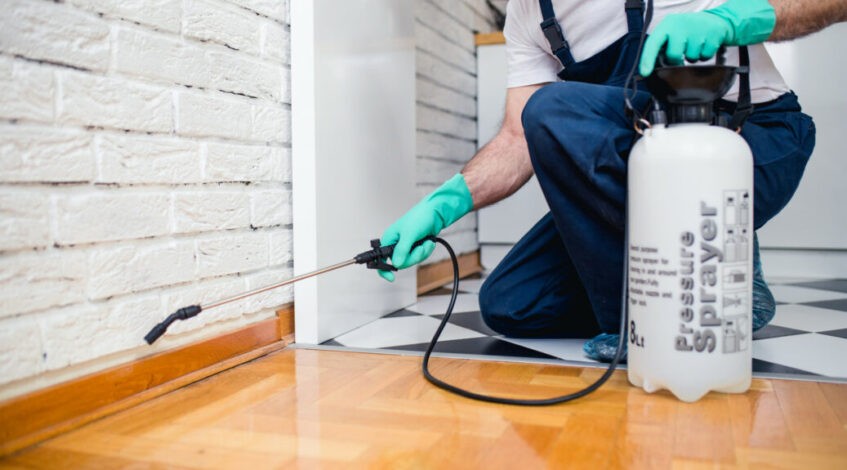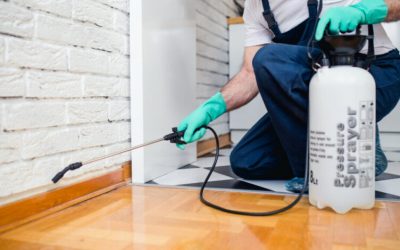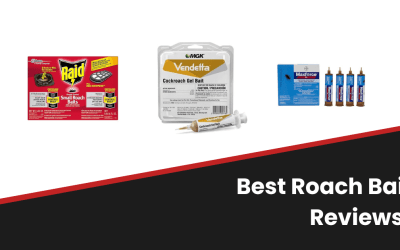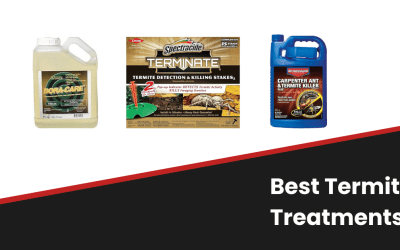Many homeowners are wary of taking care of a termite infestation themselves, believing that trained professionals are the only people who can deal with such a situation. However, there are home remedies for termites available so that he can take steps into ensuring the safety of his home.
DYI Termite baiting
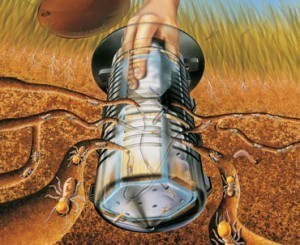
Termite baiting kits are available on the market if you are interested in a DIY termite treatment that is inexpensive to set up. All it requires of the homeowner is to set up the stations near an area where the termites are known to thrive. This can be near the perimeter of your home and throughout your yard. Basically, the more stations you have, the more likely that the termites will find the food source and bring it back to the colony. What makes this treatment so effective is that it can be done over and over again without any risk to your health or that of your family. It’s definitely a safer alternative if you’re looking for how you kill termites naturally instead of using toxic chemicals and poisons.
However, if you’re not keen on purchasing baiting traps from the store, there is an even cheaper alternative: cardboard boxes. Simply take any that you have, soak them in water, and leave them around the perimeter of your house, both inside and outside. It won’t take long for them to find this delicious food source and start chowing down. Once the boxes have become infested with them, simply throw them onto a burn pile and kill the termites that way. It may take some time to completely eradicate them from your home, but it’s a simple and very cheap process that can be done as many times as necessary to make your home termite-free.
DIY Termite Baiting System
If you’re interested in setting up your own termite baiting system, here are the steps you will need to take. There are a variety of different baiting systems that you can choose from, each of them acting in a slightly different way.
- Sentricon: there is only a three-step process that is needed to ensure that your home is termite-free. The main agent used here is noviflumuron, which inhibits their growth.
- Exterra also uses a growth inhibitor, known as diflubenzuron.
- Firstline is similar to Sentricon, except that corrugated cardboard is used and is treated with sulfluramid, which interferes with the termite’s ability to process the food they’ve eaten.
- Subterfuge is a much newer baiting system that uses hydramethylnon to inhibit growth, and there are no initial wooden monitors that are placed within the stations.
- The Advance system also uses diflubenzuron, similar to Exterra, which has made it easier for termites to transition between the wooden monitors and the chemically-treated bait.
Step-by-Step DIY Termite Baiting
- First, there is the installation of monitoring stations around the foundation of the home. The stations are placed into a hole in the ground, and are slotted with holes to grant the termites entry to get to the food inside. Untreated wood is placed in these stations in order to detect the presence of any termites near the home. These are typically installed every ten feet or so, but more can be introduced in order to increase the chances of the termites taking the bait.
- Secondly, the untreated wood is then replaced with the bait that has been laced with a slow-acting agent, allowing them to take the food back to the colony and further spread it to the other inhabitants. This way, it’s not only the foraging termites that die, but the rest of the population within the nest as well. The presence of termite corpses within the baiting traps would lead others to avoid them altogether. The termites that have taken the bait are then placed in a separate bait tube where they are returned to the soil. By doing this, they leave behind a unique scent that the other termites can follow back to the food source, further increasing the numbers that are affected by the chemically-treated bait.
- Lastly, there is continued monitoring to ensure that the baits are replaced once the stations are empty. Allowing them to remain empty will force the termites to return to your home and continue make a feast out of it.
Using chemical treatments to get rid of termites yourself
In learning how to kill termites, chemical treatments to the soil are usually a go-to option.High pressured sprayers have been in use for decades, and are very good at applying termite chemical treatments around the home and throughout one’s yard. These sprayers aren’t too expensive, and can be multipurpose, according to your needs. This makes it easy for you to take the necessary steps in knowing how to get rid of termites yourself. At least, it makes the infestation less of a problem before you hire an exterminator if the damage is more extensive than you realize.
In applying the chemical treatments yourself, there are a few simply tools that you’ll need to get started in order to prevent any damage from coming to your home. Always be sure to read the safety label of whatever chemical treatment product you buy, as this is essentially poison you are applying to the area around your home.
To outside foundations and beam structures, you’ll need a small shovel and a five-gallon bucket. Trenches need to be dug around the perimeter of the home, and the chemical termite treatment can be mixed in the bucket and then applied to the trenches. The ratio is typically one-half gallon of termiticide for every foot of trench.
For the interior of the house, you can use a wall foamer to apply the necessary chemicals to the interior of your home. Because the termites are likely to be settled within small cracks and between areas of your home, the foam can penetrate these areas that would have been difficult to get to under normal circumstances. The termite chemical treatment is typically mixed with a foaming agent in order to disperse it effectively.
Step-by-Step guide to do Termite Treatment using chemicals yourself
In applying your own chemical treatment to prevent termites, it’s important that all steps of the product are complied with in order to ensure your own safety and health, as well as those of your family and pets. A chemical treatment procedure is designed, however, to be as simple as possible so that it can be repeated in the future.
Firstly, the foundation of your home has to be measured in order to determine how much chemical you’ll need. Depending on the chemical treatment you’re using, it will state on the instructions how much should be applied every ten or twenty feet, so by measuring, you can determine how many bottles of chemical you’ll need to buy.
The next thing you’ll need is a large bucket to mix the chemical in, a mattock grabbing hoe to apply the substance, and a shovel to dig your trenches. They should be at least four to six inches wide and four to six inches deep along your foundation wall.
Next, the chemical should be applied to the trench, marking every ten or twenty feet with some kind of marker, such as a brick or roof shingle to dam up the trench. You want an even amount of product to be distributed, as well as an effective amount in order to kill the termites.
The next step is to mix the chemical with water, according to the ratio instructions stated on the product’s labeling, and then to pour the treatment into the trenches, using the hoe to mix the dirt with it so that it can penetrate the lower layers and get to the termites living deep within the soil.
During construction
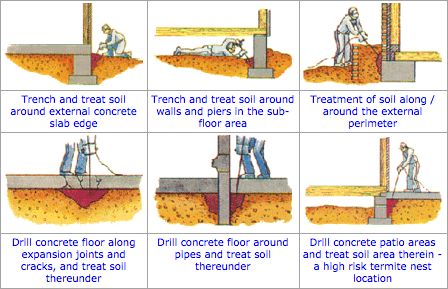
Instead of learning how to kill termites yourself, why not prevent them altogether while your new home is being built? During the construction of one’s home, there are a number of steps that can be taken to prevent the infestation of termites after completion. One such option is treated lumber. Encouraging your contractor to employ the use of these materials will keep the termites away throughout the lifetime of your home. Treated lumber typically will be stamped and state on its packaging where it should be used throughout the home, depending on the levels of chemicals it has been treated with. The most common use is in the subterranean areas of your home that will be in contact with soil, as these areas tend to be moist and can make it more enticing for subterranean termites to work their way in.
The use of treated lumber can make the overall construction costs more expensive than without them, but it can save you a lot of money in the long run from having to hire an exterminator to get rid of an infestation for you. However, keep in mind that treated lumber is not a 100 percent preventative against termites. It can significantly reduce the chances of an infestation, but it is still possible for them to get inside your home.
Another option is to treat the soil itself surrounding the home. This process has several stages that need to be taken in order to minimize the risk of one’s home to termites. This should be done before there is any slab placement in the ground in order to create a protective barrier between the masonry and the ground slab. This can be time-consuming and difficult for most homeowners to complete, building trenches and the application of the chemical product to the ground, but with care and patience, a lot of money can be saved from hiring a professional to do the job for you.
Natural Termite Treatment
If you want to know how to get rid of termites on your own the natural way, without the use of any chemicals, there are a variety of options left open to you.

Some natural oils that can be applied to the wood in your home to keep termites out and stop them from coming back. These include clove bud oil, vetiver oil, orange oil and neem oil. Vetiver oil is known for keeping termites away, while clove bud oil has been known to kill the termites within a few hours of exposure. Orange oil is very effective at killing drywood termites, due to the fact that it contains d-limonene. Neem oil is only effective when ingested by the termites, so it should be applied to aeny wood that is currently being used as a food source. What’s beneficial about the use of these oils is that they are mostly safe around people and pets. Care should be taken with clove bud oil, as it has been shown to cause liver and kidney toxicity in both cats and dogs if skin contact is made.

Aloe is another beneficial alternative, if you’re not keen on applying strong-smelling oils around your home. Simply crush an aloe plant in water and allow the mixture to sit for a few hours before straining it. Add the mixture to water in a 1:5 ratio, pour into a spray bottle and apply directly to the termites themselves. The problem with this method is that it can only be applied to areas where the termites are visible; it doesn’t cover the deeper areas of the home that you may not be aware of, allowing the numbers to recover if they aren’t taken care of.
Heat and cold treatments can be easier processes for the homeowner to use, but are only effective against drywood termites.
- For a heat treatment, it’s important to remove certain things from your home in order to prevent any damage from coming to them. Once the structure is sealed, air that reaches temperatures of 120 to 140 degrees Fahrenheit is necessary to kill the termites. This only needs to be done for a period of thirty to forty-five minutes to ensure that all of the termites have been taken care of. The heat treatment process involves the use of nylon tarps to create a tent around the home to keep the heat trapped inside. This way, propane heat is blown into the structure so that a temperature of 120 degrees Fahrenheit or higher is achieved. Fluctuations are typically monitored in order to ensure that the heat is even throughout, in order to ensure that the termites won’t find sanctuary in a different part of your home. The process can take anywhere between four to twelve hours per unit in the home to be effective.
- A cold treatment, on the other hand, takes a much longer time to be effective. A temperature of fifteen degrees Fahrenheit must be attained, and must continue for a period of at least four days in order to kill a termite colony. In a cold treatment, liquid nitrogen is pumped into the small areas where termites are known to live, along with probes to measure the temperature. Any temperature below fifteen degrees Fahrenheit should kill the termites outright. This process takes at least thirty minutes per unit in the home.
Another treatment option may cause some homeowners to squirm, and involves the use of biological components: the termite’s natural predator, the nematode. These are microscopic creatures that feed on termite larvae, causing the population to decline before they can reach adulthood. These creatures can be introduced to the soil surrounding one’s home, making them very effective against subterranean termites, and are harmless to both humans and pets.

